What Does Nitrous Do To A Car?
August 4, 2023
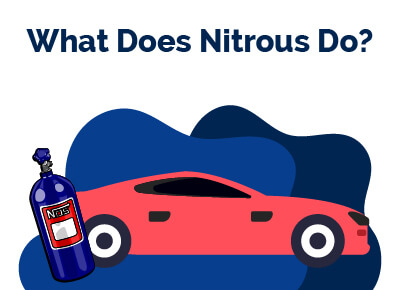

I am a serial entrepreneur and a consumer advocate. When I’m not helping car buyers, I love working on ventures that have a positive impact.
I run a cause marketing agency and serve on the board of Vayu Global Health where we are disrupting the medical industry and preventing the needless deaths of mothers and babies during childbirth.
Despite its reputation in popular culture, the reality of nitrous oxide is far more intriguing and scientific.
Nitrous oxide, or NOS as it's commonly known in racing circles, can supercharge an engine’s performance like nothing else...
Yet many are still unaware of how this mysterious compound works its magic under the hood.
Table of Contents
- The Power of Nitrous Oxide in Boosting Car Performance
- Safety Considerations When Using Nitrogen Atoms in Engines
- Tuning Your Car for Optimal Performance with Nitrous Oxide
- Debunking Common Misconceptions About Nitrous Oxide
- Legal and Regulatory Concerns Surrounding NOS Engines
- Best Car Deals by Category
- Frequently Asked Questions
The Power of Nitrous Oxide in Boosting Car Performance
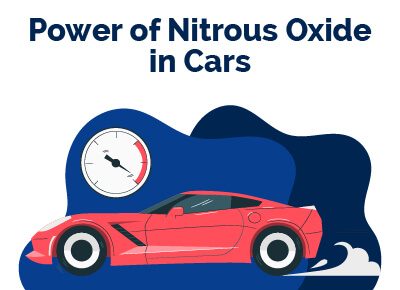 Imagine giving your car a significant horsepower boost with just one addition. This is the magic that nitrous oxide brings to your vehicle.
Imagine giving your car a significant horsepower boost with just one addition. This is the magic that nitrous oxide brings to your vehicle.
Nitrous oxide, also known as laughing gas, isn't only for dental procedures or whipping cream; it's an effective tool for enhancing a car's performance too.
This chemical compound has unique properties when heat is applied. When heated inside an engine, nitrous oxide breaks down and releases oxygen atoms into the combustion chamber.
This release aids in the combustion process. More oxygen means more fuel can be burned, resulting in higher speed and power output from your stock engine.
Cooling Effect on Intake Air
Nitrogen atoms present within this compound have another trick up their sleeve. They cool down intake air dramatically during injection into the gasoline engine.
In essence, they act like an intercooler packed inside a tiny bottle. The cooler intake charge results in denser air entering cylinders which further improves combustion efficiency.
If you're looking to make your car continuously perform at its peak without major modifications, then adding a nitrous kit might be worth considering.
Beyond Drag Racing: Everyday Applications Of Nitrous Oxide Systems
You may associate nitrous systems primarily with drag racing due to movies like Fast & Furious but these kits aren't limited solely for track use.
Sodium chlorate acts similarly by providing additional oxygen inside engines, thus improving overall performance whether you're on a racetrack or highway.
Dry Nitrous System
In contrast, a dry nitrous system introduces nitrous oxide into the intake manifold without any additional fuel.
This type of system relies on the engine's existing fuel injectors to provide the necessary fuel for combustion.
While this setup may seem simpler, it can be more challenging to achieve the correct air-fuel ratio, leading to potential engine damage if not properly tuned.
Single Fogger Systems
A single fogger system is a common type of nitrous oxide system that injects nitrous oxide and fuel into the intake manifold through a single nozzle.
This setup is relatively straightforward and provides a noticeable increase in horsepower.
However, it could be less effective than other systems in terms of fuel distribution, potentially causing inconsistent results.
Multiple Fogger Systems
Multiple fogger systems utilize multiple nozzles to inject nitrous oxide and fuel into the intake manifold.
This setup allows for more precise control over the distribution of nitrous oxide and fuel, resulting in improved performance and consistency.
However, the complexity of installation and tuning may be higher compared to single fogger systems.
Safety Considerations When Using Nitrogen Atoms in Engines
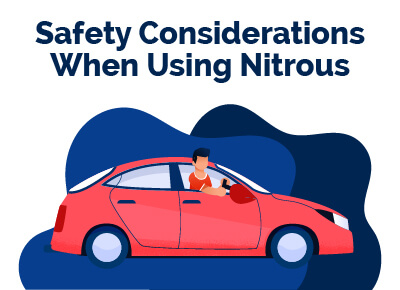 Using nitrous oxide as a performance enhancer for cars may offer increased horsepower and speed, yet it can be dangerous if not handled properly.
Using nitrous oxide as a performance enhancer for cars may offer increased horsepower and speed, yet it can be dangerous if not handled properly.
This potent chemical compound can indeed provide a significant horsepower boost and higher speed, but it also has the potential to be volatile if misused.
The Risks of Misuse
Nitrous oxide systems require careful handling due to their inherent volatility.
A poorly installed nitrous kit could lead to catastrophic engine damage, compromising your car's performance permanently.
It is important to note that incorrect use of nitrogen atoms within an engine means risking detonation, the uncontrolled explosion of fuel inside the combustion chamber, which can shatter pistons and bend rods.
Maintaining Engine Safety with Nitrous Oxide Systems
To ensure safety while achieving optimal car continuous performance using a nitrous system, proper installation is crucial.
"A well-designed intake charge combined with precise timing adjustments will make sure you get all the benefits from your stock engine."
- An experienced professional should install your nitrous oxide kit correctly.
- Routine maintenance checks are necessary after installing any high-performance modification like this one.
- Your vehicle's cooling system must be efficient enough to handle heat generated by increased power output when running on laughing gas.
Tuning Your Car for Optimal Performance with Nitrous Oxide
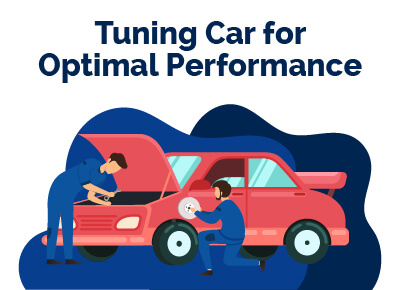 When it comes to optimizing the results of using nitrous oxide in your car, tuning correctly is essential.
When it comes to optimizing the results of using nitrous oxide in your car, tuning correctly is essential.
This isn't just about adding a nitrous kit; there are other considerations that come into play as well.
Timing Adjustments and Fuel Delivery Modifications: A Balancing Act
The engine's timing needs careful adjustment when introducing nitrous oxide into the system.
A delay in ignition timing can prevent premature combustion, which could lead to serious damage if left unchecked.
- An advanced ignition may result in detonation due to increased cylinder pressure and temperature caused by nitrous oxide injection.
- Fuel delivery modifications are equally important; they ensure adequate fuel supply during high-demand periods of enhanced power output enabled by the use of nitrogen atoms.
- Inadequate fuel supply under these conditions can cause lean running situations, damaging pistons or even causing catastrophic engine failure.
Maintaining Engine Health While Boosting Performance With Nitrogen Atoms
Nitrogen atoms' introduction should be monitored closely since their volatile nature might affect an otherwise healthy stock engine negatively if not properly managed.
Your vehicle's computer systems need recalibration too so that they understand how this new element affects overall operation-especially regarding air/fuel ratios at higher speeds facilitated by significant horsepower boost provided through intake charge enrichment via laughing gas application.
In essence, achieving optimal performance with a gasoline engine equipped with sodium chlorate acts like heat nitrous oxide, which requires understanding how different elements interact within your specific setup.
Debunking Common Misconceptions About Nitrous Oxide
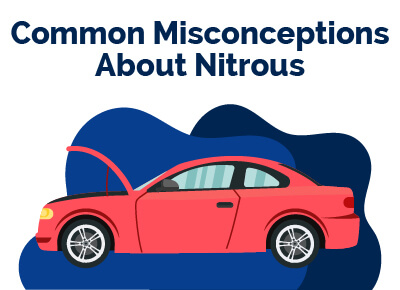 Nitrous oxide, often referred to as 'laughing gas', is a popular addition for car enthusiasts seeking significant horsepower boosts. However, misconceptions surrounding its use can deter some from exploring the benefits of this powerful chemical compound.
Nitrous oxide, often referred to as 'laughing gas', is a popular addition for car enthusiasts seeking significant horsepower boosts. However, misconceptions surrounding its use can deter some from exploring the benefits of this powerful chemical compound.
The Myth: Nitrous Damages Stock Engines
One common misconception is that nitrous oxide damages stock engines. In reality, when used correctly and in moderation, a nitrous kit can safely enhance your engine's performance without causing harm.
This misunderstanding likely stems from instances where improper installation or misuse led to engine damage-not an inherent issue with nitrous oxide itself.
The Myth: Using Nitrous Oxide Is Illegal For Street Use
A second myth suggests using nitrous oxide on street cars is illegal. While certain jurisdictions may have restrictions regarding the use of nitrogen atoms in engines due to safety concerns or environmental regulations; it isn't universally prohibited, but always consult local laws before installing any modifications.
Sodium Chlorate Acts As A Catalyst?
An additional myth proposes sodium chlorate acts as a catalyst in enhancing the combustion process within gasoline engines via oxygen release similar to heat nitrous oxides'. This claim lacks scientific basis since sodium chlorate doesn't behave like nitrogen compounds under high-temperature conditions inside an internal combustion engine.
Remember that understanding how these systems work and consulting professionals during installation are key steps toward safe usage while maximizing power output.
Legal and Regulatory Concerns Surrounding NOS Engines
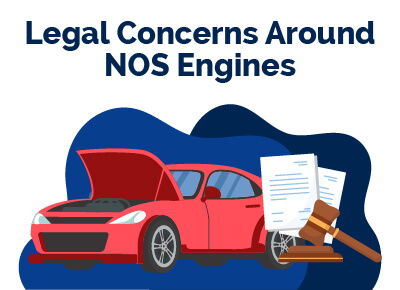 The use of nitrous oxide in car engines is not without its legal considerations.
The use of nitrous oxide in car engines is not without its legal considerations.
In certain areas, the fitting and running of a nitrous oxide system may be prohibited or regulated by particular laws.
Nitrous Oxide Systems on Public Roads
The legality of using nitrous oxide systems varies widely from one location to another.
In some areas, it's perfectly acceptable for vehicles equipped with these systems to travel public roads as long as they're deactivated during transit.
Racing Regulations and Nitrous Oxide Use
Apart from road laws, those who participate in drag racing events must also consider event-specific rules regarding engine modifications like nitrous kits.
For instance, Drag Racing Association has strict guidelines about how such systems should be installed.
Potential Penalties For Non-compliance With Laws And Regulations
If found guilty of non-compliance with local laws or race regulations concerning the usage of nitrogen atoms in your vehicle's engine means you could face penalties ranging from fines to disqualification at races.
This information emphasizes why understanding the legal landscape surrounding this significant horsepower boost technology is crucial before installing a laughing gas kit into your stock engine.
Best Car Deals by Category
Frequently Asked Questions
What effect does nitrous have on cars?
Nitrous oxide enhances a car's performance by providing more oxygen for combustion, leading to increased horsepower and speed.
Does nitrous damage your engine?
If used correctly and the engine is properly tuned, nitrous doesn't typically cause damage. However, misuse or improper installation can potentially harm the engine.
Why is NOS illegal in a car?
NOS isn't universally illegal but may be restricted in some jurisdictions or specific scenarios like street racing due to safety concerns and potential misuse.
How does nitrous work in a car engine?
Nitrous works by releasing extra oxygen when heated during combustion. This allows more fuel to burn, resulting in greater power output from the engine.
Posted in Car Buying Tips |




